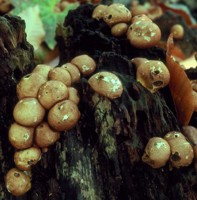DISCUSSION OF GASTEROMYCETES
The gasteromycetes are a group of fungi that are related not by ancestry but by their natural history. All members of this assemblage have basidia that no longer possess the ability to discharge their basidiospores out into their environment. Instead, when the basidiospores are mature the basidia wither away, leaving them behind in a mass. You may wonder how a fungus that has the means of actively shooting its spores can survive when this ability is lost. The answer to your question leads us directly to the diversity of fungi that have faced such a problem.

It is probably common for an individual fungus to come into the world with some kind of defect. In most cases the fungus will not be able to survive and will die before it has produced any progeny. In some unusual situations the "defect" may lead to some kind of advantage and the fungus having it will thrive and reproduce abundantly, possibly passing the "defective" genes on its progeny and thus starting a new generation of fungi with an enhanced capacity for survival and reproduction. Such may be the case in fungi that arise with the inability to shoot their basidiospores. Perhaps such fungi gain an advantage in a fiercely competitive world by keeping their basidiospores at home and not sending them off to new places. We can never know exactly what led to the proliferation of Gasteromycetes, but we are quite sure that their remote ancestors could shoot their basidiospores and that their more recent ones could not.
If a fungus cannot shoot its basidiospores away, how does it disperse them? As it turns out, in some pretty ingenious ways. The four groups of Gasteromycetes presented here differ greatly in how they have faced this challenge. These major groups are:
Puffballs
These fungi produce their basidiospores inside large enclosed basidiomata where they collect in a dry, dusty mass. Eventually the basidiomata either open by one or more pores or just irregularly split open and allow their spores a means of escape. These puffballs then act like a bellows, pushing the spores out in great smoky clouds. Some remain attached to their substrate and depend upon water drops coming down from trees to strike their basidiomata and puff out the spores. Other break loose and get blown along by the wind like small tumbleweeds, releasing spores as they roll. The details of their operation differ from one species to another, but all produce large masses of dry loose basidiospores.
Birds' nest fungi
Birds' nest fungi disperse their basidiospores by means of a device called a splash cup. Here the basidiomata do not become filled with dry spores but instead enclose their basidiospores inside special little cases called peridioles. At maturity the basidiomata ipen widely to reveal the perioles, each containing a packet of basidiospores. The basidiomata are very precisely constructed so that when a drop of water falls into the open top there is a counter-reaction that propels the peridioles away to a distance of several centimeters. In some species the peridioles become attached to blades of grass and are consumed by animals as they graze. Later the peridioles are deposited in a pile of dung where they can germinate. The name bird's nest fungi comes from the appearance of the mature basidiomata, that are open at the top and look like little nests containing a clutch of eggs.
Stinkhorns
Stinkhorns use insects to disperse their basidiospores. The basidia are produced in an inner layer of the basidioma that at maturity is raised up away from the ground. The spore masses are slimy and generally rather ill-smelling according to human standards. Flies, however, are strongly attracted to the smell and in a few hours can collect all of the slime, basidiospores and all. Presumably the narrow cyclindrical spores pass through the gut of the fly to be deposited elsewhere, but hard data is lacking.
False truffles
Real truffles are members of the Ascomycota that develop under the ground and are dug up and eaten by mammals. False truffles are members of the Basidiomycota that also develop under the ground and are dug up and eaten by mammals. This parallelism seems to have occurred because both groups form mycorrhizae and both benefit from remaining submerged in the ground near the roots of their companion tree. As with the "true" truffles, the spores of the false truffles do not become dry and would not disperse well if they did not pass through the gut of a mammal.